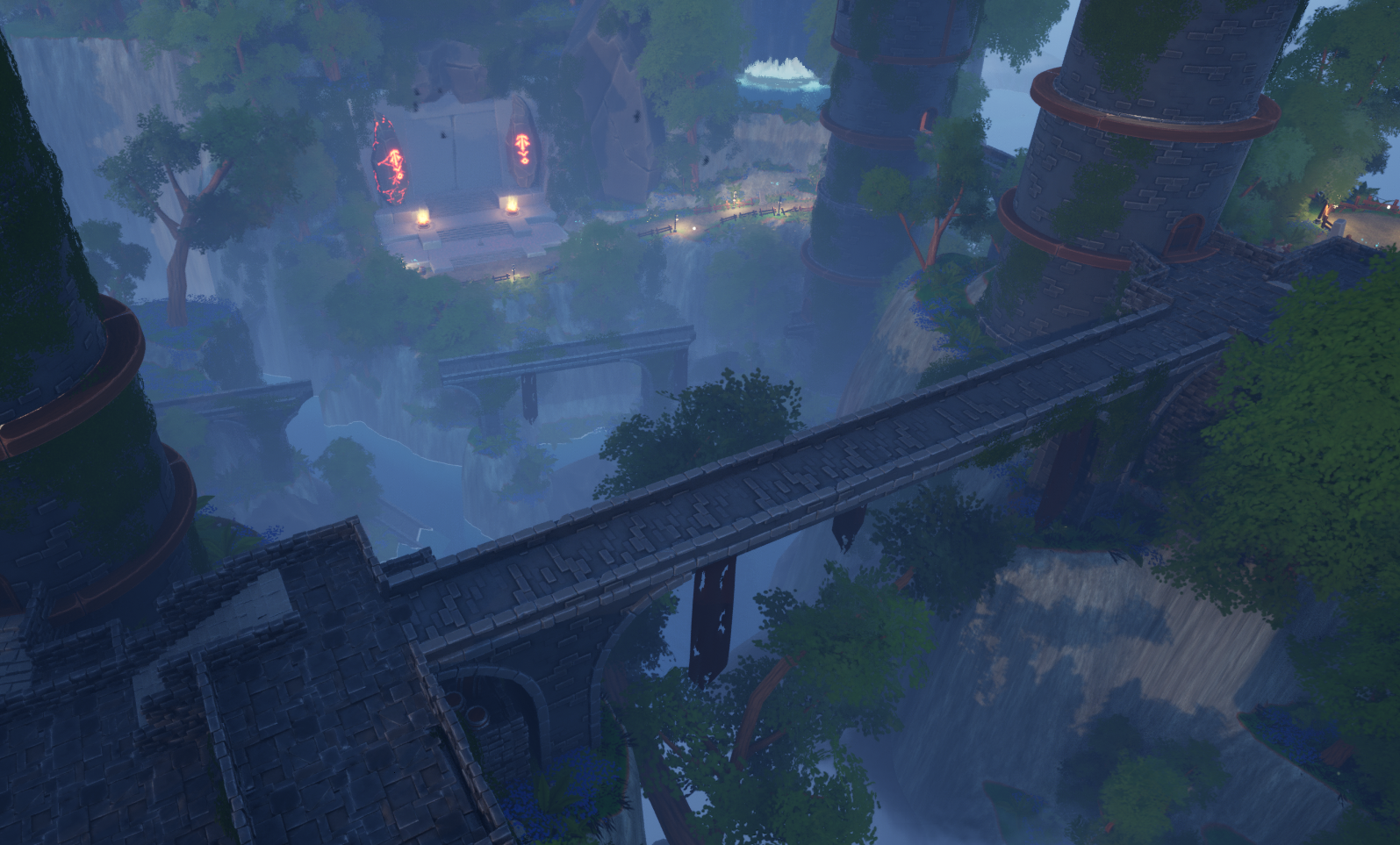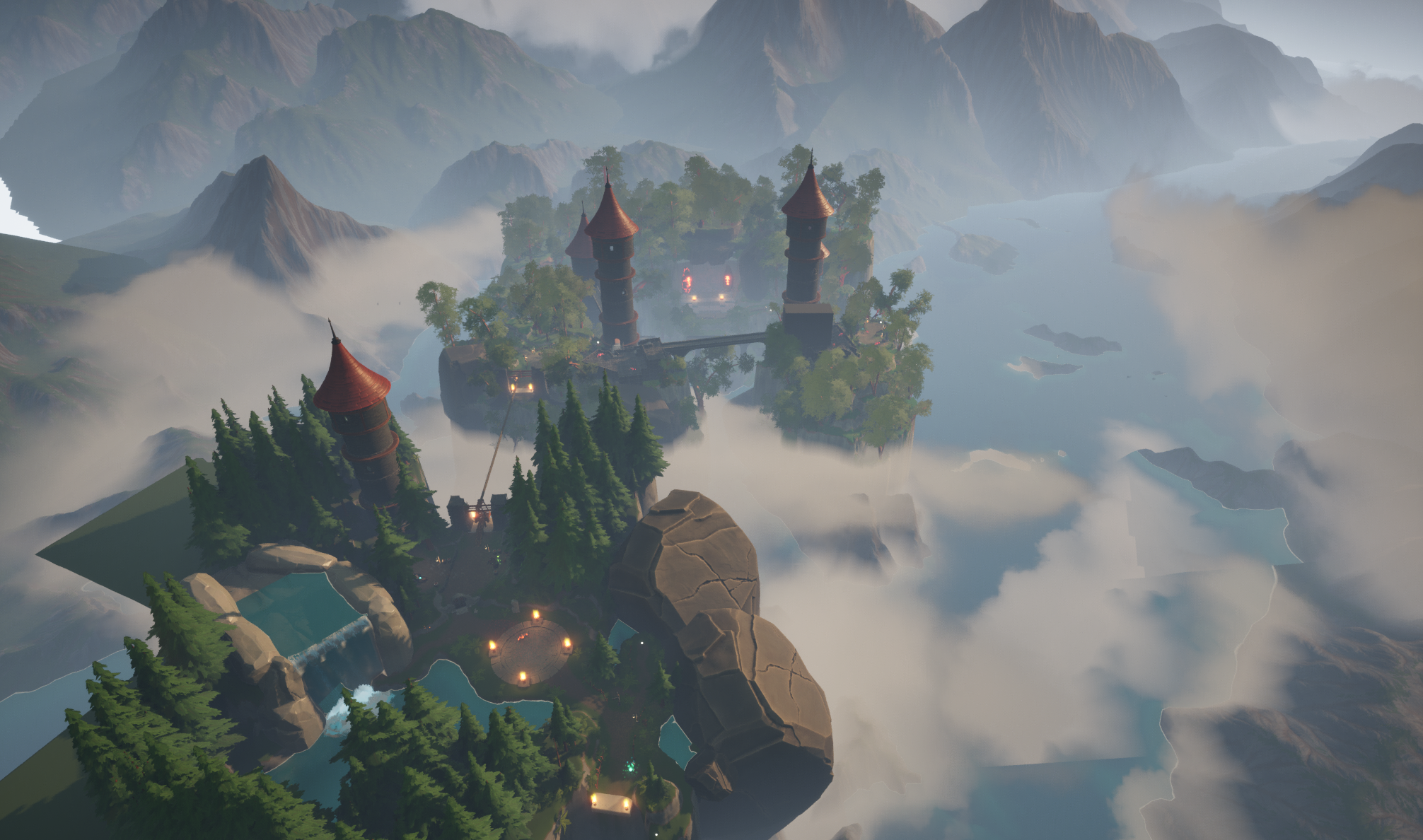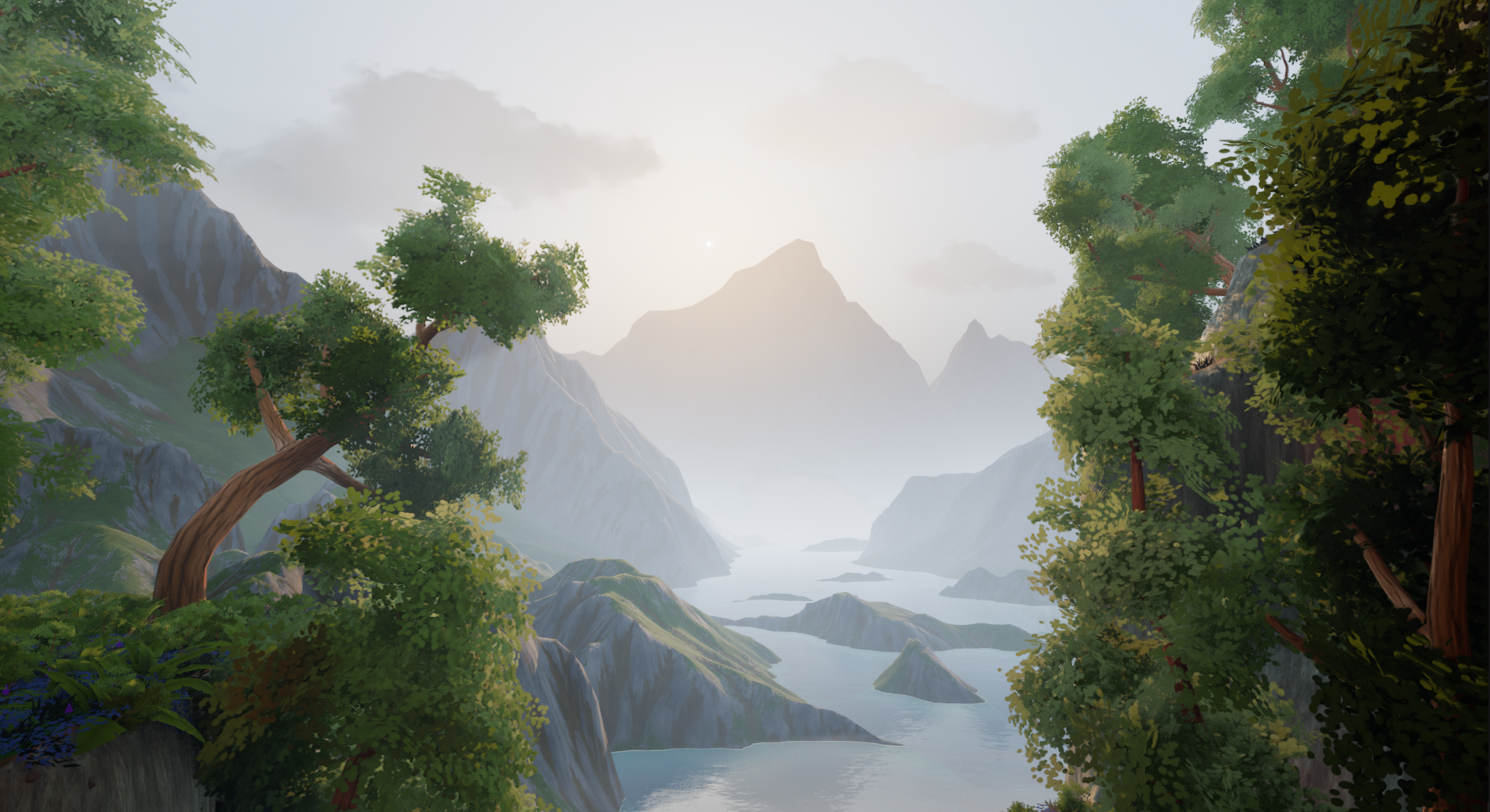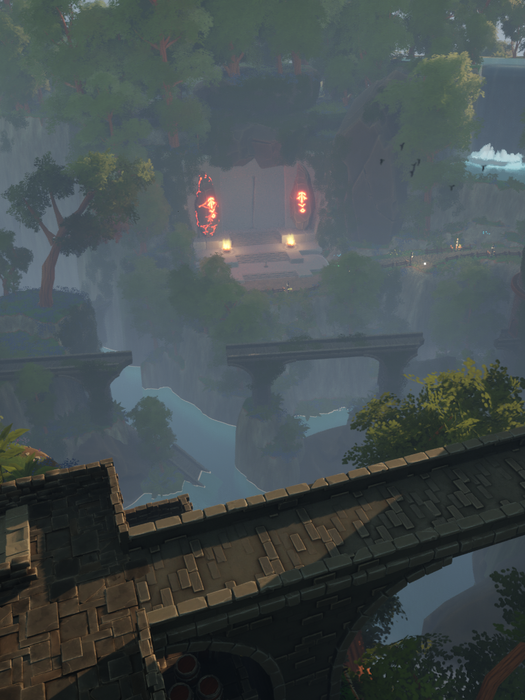

THE LANTERN BEARER
Timeline
Seven weeks
Team size
16 developers
Responsibility
Product Owner, Level Design,
3C Design, Cinematography,
Level Art, Narrative
Engine
Unreal Engine



OVERVIEW
And why it was made.
The Lantern Bearer is the third game project made at Futuregames with Unreal Engine. It is an isometric action-adventure with Soulslike elements. My responsibilities included worldbuilding, level design from concept through set dressing and technical tools, 3C game design focusing on cinematography, gameplay and dimensions + interactions of the character with the environment, managing the team and documentation.
My objective was to design a vast landscape and make a camera system which would enhance it's reception, similar to the one from No Rest for the Wicked. I tried using my film experience to focus on building the environment and framing it accordingly to highlight important game elements and interactions.
Gallery | 30 developmental images
LEVEL DESIGN
Breakdown.
I took inspiration from Bloodborne and No Rest for the Wicked when designing the environment of the game. I used lanterns and fire goblets (light sources) for guidance clarity and took advantage of a dynamic camera system. For set dressing I was able to use Dreamscape: Stylized Environment Bundle made by Polyart Studio.
The Lantern Bearer | Gameplay highlights
-
Drew concept and designed blockouts and set dressed the level.
-
Balanced enemy encounters.
-
Distributed and managed foliage using the foliage tool.
-
Adjusted level atmosphere; lighting, fog and colour grading.
-
Utilized the Landmark method, focusing on the cave's entrance which served as a clear point of interest for the players.
-
Developed technical tools such as a levers, elevator, chests, bridge, doors and goblets to present a variety of interactions using UE5 blueprints.
Gallery | Technical tool and concepts
-
Created a combat tutorial section with a weaker enemy on an arena which resembles the later found boss arena.
-
Designed a battle arena suited for the boss fight, leaving little space for mistakes and presenting a challenging fight.
-
Designed a "gym" where I tested sizes of assets and designed tool interactions, which I then shared and iterated on with system designers and artist to ensure a clear vision and understanding of dimensions and mechanics.
-
Distributed treasure and pick-ups across the level and used the follow the breadcrumbs methodology to encourage and reward exploration.
Gallery | Exploration and design gym
One standout moment in the game revolves around the "Sense of Scale." Using level exposition and composition, I created a scene that emphasizes the importance of unfolding events — a sharp contrast from the preceding levels. In doing so, I wanted to break the monotony and make an impact, reaching previously set goals.
Another "Sense of Scale" moment occurs at the game's finale, following the climax. While the ship-based scene focuses on pacing, the end moment highlights the world’s vastness. I tried to resemble the environmental storytelling style of Journey when designing these.
CHANGE IN SCALE
Sometimes less is more.
Based on feedback, I adjusted the scale of the main area and expanded it, which improved the level’s flow and encounters. This change also altered the direction from which the character approaches the bridge. I switched the direction from right to left to left to right to enhance cognitive ease and reduce cognitive load, creating a natural visual flow that aligns with reading patterns. In both instances shown in the gallery, I utilized the landmark methodology effectively. I used the camera to emphasize the cave’s entrance and designed the environment to ensure the entrance is visible from various parts of the level.
Gallery | Change in scale
PROBLEMS ENCOUNTERED
And how I solved them.
Boring enemy encounters:
-
Solved by adjusting the size of different areas to allow for for a more challenging and meaningful encounters.
Narrative:
-
Due to the rapid nature of game projects like this, the story had to be minimized to environmental storytelling which I tried to implement through small story pieces scattered around the map as well as a little note at the start of the game to paint the picture of our setting.
Pacing:
-
Similarly to the encounters, restructuring of the levels and playtesting feedback allowed for an improved gameplay space and additional introduction of new combat mechanics which enhanced the fun and pacing of the game.
REFLECTION
For future reference.
I enjoyed researching From Software games and Moon Studios’ No Rest for the Wicked. It was interesting to see how they design levels and place encounters to affect gameplay and player progression. I tried to create a similar experience but with a more straightforward approach, giving the illusion of choice. In future projects, I want to focus more on the architectural side of level design, using landmarks and creating cinematic, stunning views through thoughtful design.
TAKEAWAYS
Almost done.
-
Make better use of the landscape tool which would allow for smoother transitions between different parts of the level and smoother blend of environments.
-
In a setting that tries to resemble Bloodborne or No Rest for the Wicked level design style, it is crucial to have the areas well planned out. It should be obvious to the player that these different parts are to be explored, hold something exciting to them.
-
Working in a team as large as this again, I tried focusing more on communication and emphasize the collaborative process of development, providing and adjusting to feedback and cross-department dependency which helped create the project.





THE LANTERN BEARER
Timeline
Seven weeks
Team size
16 developers
Responsibility
Product Owner, Level Design,
3C Design, Cinematography,
Level Art, Narrative
Engine
Unreal Engine

OVERVIEW
And why it was made.
The Lantern Bearer is the third game project made at Futuregames with Unreal Engine. It is an isometric action-adventure with Soulslike elements. My responsibilities included worldbuilding, level design from concept through set dressing and technical tools, 3C game design focusing on cinematography, gameplay and dimensions + interactions of the character with the environment, managing the team and documentation.
My objective was to design a vast landscape and make a camera system which would enhance it's reception, similar to the one from No Rest for the Wicked. I tried using my film experience to focus on building the environment and framing it accordingly to highlight important game elements and interactions.
Gallery | 30 developmental images
LEVEL DESIGN
Breakdown.
I took inspiration from Bloodborne and No Rest for the Wicked when designing the environment of the game. I used lanterns and fire goblets (light sources) for guidance clarity and took advantage of a dynamic camera system. For set dressing I was able to use Dreamscape: Stylized Environment Bundle made by Polyart Studio.
The Lantern Bearer | Gameplay highlights
-
Drew concept and designed blockouts and set dressed the level.
-
Balanced enemy encounters.
-
Distributed and managed foliage using the foliage tool.
-
Adjusted level atmosphere; lighting, fog and colour grading.
-
Utilized the Landmark method, focusing on the cave's entrance which served as a clear point of interest for the players.
-
Developed technical tools such as a levers, elevator, chests, bridge, doors and goblets to present a variety of interactions using UE5 blueprints.
Gallery | Technical tool and concepts
-
Created a combat tutorial section with a weaker enemy on an arena which resembles the later found boss arena.
-
Designed a battle arena suited for the boss fight, leaving little space for mistakes and presenting a challenging fight.
-
Designed a "gym" where I tested sizes of assets and designed tool interactions, which I then shared and iterated on with system designers and artist to ensure a clear vision and understanding of dimensions and mechanics.
-
Distributed treasure and pick-ups across the level and used the follow the breadcrumbs methodology to encourage and reward exploration.
Gallery | Exploration and design gym
One standout moment in the game revolves around the "Sense of Scale." Using level exposition and composition, I created a scene that emphasizes the importance of unfolding events — a sharp contrast from the preceding levels. In doing so, I wanted to break the monotony and make an impact, reaching previously set goals.
Another "Sense of Scale" moment occurs at the game's finale, following the climax. While the ship-based scene focuses on pacing, the end moment highlights the world’s vastness. I tried to resemble the environmental storytelling style of Journey when designing these.
CHANGE IN SCALE
Sometimes less is more.
Based on feedback, I adjusted the scale of the main area and expanded it, which improved the level’s flow and encounters. This change also altered the direction from which the character approaches the bridge. I switched the direction from right to left to left to right to enhance cognitive ease and reduce cognitive load, creating a natural visual flow that aligns with reading patterns. In both instances shown in the gallery, I utilized the landmark methodology effectively. I used the camera to emphasize the cave’s entrance and designed the environment to ensure the entrance is visible from various parts of the level.
Gallery | Change in scale
PROBLEMS ENCOUNTERED
And how I solved them.
Boring enemy encounters:
-
Solved by adjusting the size of different areas to allow for for a more challenging and meaningful encounters.
Narrative:
-
Due to the rapid nature of game projects like this, the story had to be minimized to environmental storytelling which I tried to implement through small story pieces scattered around the map as well as a little note at the start of the game to paint the picture of our setting.
Pacing:
-
Similarly to the encounters, restructuring of the levels and playtesting feedback allowed for an improved gameplay space and additional introduction of new combat mechanics which enhanced the fun and pacing of the game.
REFLECTION
For future reference.
I enjoyed researching From Software games and Moon Studios’ No Rest for the Wicked. It was interesting to see how they design levels and place encounters to affect gameplay and player progression. I tried to create a similar experience but with a more straightforward approach, giving the illusion of choice. In future projects, I want to focus more on the architectural side of level design, using landmarks and creating cinematic, stunning views through thoughtful design.
TAKEAWAYS
Almost done.
-
Make better use of the landscape tool which would allow for smoother transitions between different parts of the level and smoother blend of environments.
-
In a setting that tries to resemble Bloodborne or No Rest for the Wicked level design style, it is crucial to have the areas well planned out. It should be obvious to the player that these different parts are to be explored, hold something exciting to them.
-
Working in a team as large as this again, I tried focusing more on communication and emphasize the collaborative process of development, providing and adjusting to feedback and cross-department dependency which helped create the project.

Optimization for tablets is in progress.
Please use your desktop or phone when viewing,
Best experience: 1080p or 1440p.









































